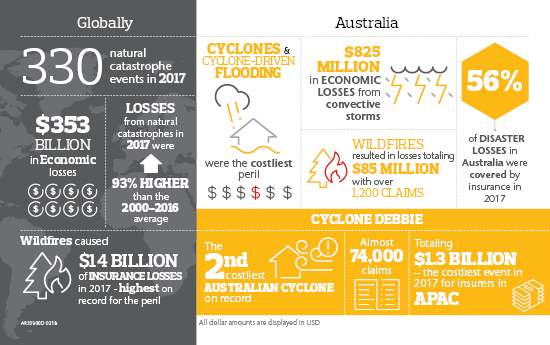Weather, Climate & Catastrophe Insight: 2017 Annual Report
Impact Forecasting – Aon Benfield’s catastrophe model development centre – released its Weather, Climate & Catastrophe Insight: 2017 Annual Report, which evaluates the impact of worldwide natural disaster events during 2017. The report aims to help businesses, communities, governments and the re/insurance industry to better prepare for and boost resilience against the growing risks of natural catastrophes.
The report reveals that there were 330 natural catastrophe events in 2017 that generated economic losses of USD353 billion – of which 97 per cent was due to weather-related events, including Cyclone Debbie in Australia, Hurricanes Harvey, Irma and Maria in the US and Caribbean, and Typhoon Hato in China. 2017’s natural catastrophe losses were 93 per cent higher than the 2000-2016 average.
Cyclone Debbie triggered widespread and extensive flooding across eastern Australia in March 2017 and became the second-most costly Australian cyclone on record after Cyclone Tracy devastated Darwin in 1974. Cyclone Debbie prompted nearly 74,000 claims to be filed across eastern Australia, amounting to USD1.3 billion and was the costliest event of the year for insurers in Asia-Pacific.
Peter Cheesman, Head of Aon Benfield Analytics Asia Pacific, commented: “In Australia, the losses from Cyclone Debbie demonstrate that the key drivers of property damage in cyclones can vary significantly depending on the event. In slow-moving events like Cyclone Debbie, the majority of damage was caused by localised flooding and water ingression rather than direct wind damage to the exterior structure. Major flooding also occurred up to a week after the cyclone initially made landfall making interpretation of the hours clause critical in speculating losses.”
Steve Bowen, Impact Forecasting director and meteorologist, said: “The high cost of disasters in 2017 served as a reminder that we continue to face increasing levels of risk as more people and exposures are located in areas that are particularly vulnerable to major, naturally occurring events. As weather scenarios grow more volatile in their size and potential impact, it becomes more imperative than ever to identify ways to increase awareness, improve communication, and lower the insurance protection gap. We know natural disasters are going to occur. The question is how prepared are we going to be when the next one strikes.”
Snapshot of key findings

Preparing your business for a catastrophe
The statistics demonstrate the impacts of natural catastrophes are becoming increasingly significant – preparing your organisation for a catastrophe is as important as ever. Our team of Risk Control & Engineering consultants provide specialist advice to help minimise the frequency and the consequence of an expected loss from a natural catastrophe.
Regardless of the nature and location of their business, all companies need a rigorous plan to help prepare for worst case scenarios. Effective Business Continuity Management provides a framework for building organisational resilience. Having capacity for an effective response can help safeguard the interests of key stakeholders, reputation, brand and value-creating activity. It’s not enough to have a plan in the top drawer – it needs to be regularly reviewed, updated and tested. Business continuity planning often falls apart when the capability to execute is lacking. Scenario testing builds this capability across the leadership team, empowering a structured and effective response to a significant catastrophe.
The importance of the correct coverage
Typically businesses only have 50-75% of the correct value of their assets insured. The risk of getting it wrong can be substantial. Ultimately, it is the directors of the business who bear the responsibility for declaring insured values and they can be penalised for misrepresentation in the event of a claim. You can eliminate any underinsurance risks by having your organisation’s assets properly assessed by a qualified insurance valuer from our Valuation Services team.
For more information on how Aon can help your organisation to manage natural catastrophes, fill out a form to start a conversation with one of our risk consultants.
Read the full Weather, Climate & Catastrophe Insight: 2017 Annual Report here.